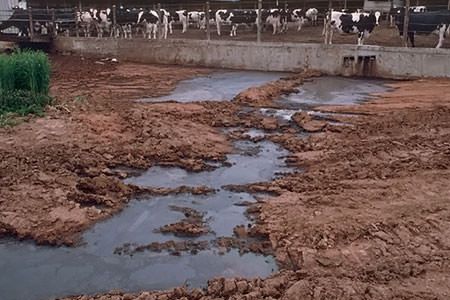Livestock Farm Wastewater Treatment - Overview
Published on by Anna Morynets, Project Manager at GlobeCore in Technology
The degree of contamination of wastewater is characterized by the amount of mineral, organic and bacterial materials solved or unsolved in the water. Wastewater is treated by mechanical, chemical, physical or biological methods.

Biological processes involve oxidation of organic substances in waste water in the form of suspensions, colloids and solutions by microbes.
There are two type of facilities for biological treatment of wastewater. The first type are facilities where biological treatment occurs in conditions similar to natural (sewage farms, absorption fields and biological sewage ponds. The second type are facilities with artificial conditions (biological filters and aerotanks). The treatment process in the first group occur slowly, with the oxygen in the soil and in the water and due to the metabolism of microbes, which oxidize organic contaminants. Treatment is much more intensive in the second group of facilities.
Since the requirements to the degree of wastewater treatment keep growing, and biological treatment alone may not always be able to meet them, livestock farm wastewater must be processed additionally.
Treatment of such wastewater is a complicated process. It requires thorough consideration of the capabilities of each facility on a case by case basis. Methods used for such treatment are biological (biological ponds with natural or biological aeration) and physical and chemical (flotation, sorption and ozonation).
Every milliliter of livestock farm wastewater contains 10^8 of aerobic and up to 10^7 of anaerobic bacteria, therefore thorough decontamination must precede release of the water into water bodies or into sewage farms.
Biological wastewater treatment facilities are available to large livestock farms, but even their wastewater does not meet the purity requirements for release into water bodies. Purification of such wastewater is quite complicated. It requires two problems to be solved: technical and technological. The former occurs with pumping of wastewater and its mixing in tanks. The latter is related to the quality of processed water and the cost of its treatment. The cost of purifying highly concentrated wastewater from livestock farms with traditional treatment methods is defined by the energy cost of the process and the formation of large amounts of sludge.
Sometimes the problem of removing nitrogen and phosphorus from waste water arises.
Technical problems are solved by using modern equipment. For instance, for pumping of waste with high concentration of manure, hay or sand, submerged pumps with special wheels of various types are used.
The characteristics of wastewater must be taken into account, among them the concentration of suspended particles, abrasive particles, fibers etc.
For economical solution of mixing highly concentrated waste water, submerged mixers are used.
Aeration, the process of supplying oxygen to the biological processes, has always been problematic for livestock farm wastewater treatment. DUe to the high content of salts, organics and surfactants formed in the process of hydrolysis, the mass transfer of oxygen is 40% slower than in fresh water.
For a time, these problems were addressed by using ejector aerators with submerged pumps.
They have since been replaced by submerged pneumatic/mechanical aerators, which operate on the principle of atomizing bubbles with consecutive horizontal stirring of the sludge with a powerful stream generated by the mixer.
This results in formation of very small bubbles and high oxygen saturation.
Biological treatment of livestock wastewater is performed in two stages. Removal of nitrogen and phosphorus is not provided for in such facilities, as a rule. The high energy costs and a large amount of sludge is an unavoidable part of wastewater treatement.
The development of pneumatic and mechanical aerators and their capability of stirring without air facilitates the process of nitrodenitrification with periodic aeration without additional equipment, to set up the aeration process when oxygen is available and stirring when it is not.
The new technology is based on nitrodenitrification (a biological method of nitrogen removal) and anaerobic treatment of wastewater.
In the process of anaerobic purification, fatty acids are removed, hydrolysis of organic material occurs with formation of ammonium nitrogen. The result is the growth of pH to 7.6-7.9, with the formation of magnesium-ammonium-phosphate, which settles on the walls of pipelines. Up to 80-90% of phosphorus is removed.

Media
Taxonomy
- Wastewater Use
- Reclaimed Wastewater
- Decentralized Wastewater
- Wastewater Treatment
- Livestock Production
- Livestock nutrition
- Farms